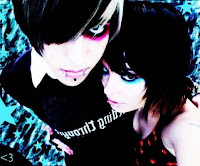The last knockings of 70's punk was beginning to breathe its last as it lurched into the early years of the 1980's. As it finally keeled over, a less aggressive, more melodic music scene developed in Washington DC. Withdrawing from the violence and harder edge of punk, this made way for lyrics with a more emotional connection. Instead of exploring violence, personal feelings were the priority. While not exactly the emo movement we've seen in recent years, it gave rise to the term 'emo-core' - a music magazine buzzword derided by its musicians and bands.
This movement only lasted into the mid-eighties, although the the influence of the bands - like Rites of Spring and Embrace - were felt across America for many years afterwards. Pulling in other influences, such as British fatalists The Smiths, along with over-theatrical rock lyricism, the emo-core movement carried on. By the early-nineties, American punk (very different to the acts of the 70's), was a mainstream affair. Emo-core - now shortened to emo - bands were seen as a champion of the independent label, with fans that made it their aim to follow these acts irrelevant of big record label marketing.
Emo in the new millennium
Throughout the 90's, emo bands were being noticed by the big companies, with bands such as Jimmy Eat World, New Found Glory and Samiam making signings. This was the beginning of the emo movement finding its way into the mainstream, as the media found a fascinating new sub-culture to champion or demonise. It wouldn't be until the turn of the millennium that it emo would begin to be a word known to those outside of the scene.
It was the summer of 2002 that emo seemed to explode in the public consciousness. There had been no new rock movement for years, and rap and R'n'B were dominating the pop charts. For the disenfranchised teens of America, and beyond, emo seemed like the perfect antidote. Instead of glorifying the world of more money, more jewellery and more girls, emo celebrated the flipside. It spoke to the losers, or rather, those that embraced that feeling of being in the dark and lost.
The image of the emo is now familiar to the Western world. The thick eyeliner and overhanging fringe on boys and girls has created animosity in various communities. As with music-centric genre, it may vanish or evolve, but the first decade of the 21st century belongs to the emo.


No comments:
Post a Comment